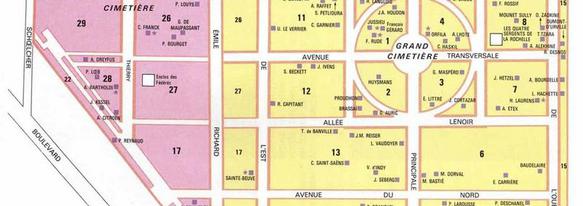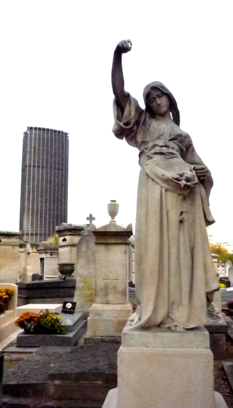Copyright 2017 Creative Travel Publications, LLC
FAMOUS WOMEN AT MONTPARNASSE CEMETERY
SINGERS MUSICIANS COMPOSERS WRITERS
Maryse Bastie (1823 - 1891) writer, poet
Marguerite Duras (1914 -1996) writer, director
Clara Haskil (1885 - 1960) pianist
Joelle (1953 - 1982) singer
Mirelle (1906 - 1996) singer, composer
Kiki "Queen of Montparnasse" (1901 - 1953) singer, actress
Susan Sontag (1933 - 2004) philosopher, writer
Wikipedia.com - Montparnasse Cemetery
ACTRESSES DANCERS MODELS ACTIVISTS
TIna Aumont (1946 - 2006) actress
Isabelle Caro (1982 - 2010) model
Sylvia Lopez (1931 - 1959) actress
Rosita Mauri (1849 - 1923) ballerina
Maria Montez (1912 - 1951) actress
Jean Seberg (1938 - 1979) actress, activist
Delphine Seyrig (1932 - 1990) actress
Sabine Zlatin (1907 - 1996) activist
Wikipedia.com - Montparnasse Cemetery
Marie Dorval
(1798 - 1849)
Actress
Simone de Beauvoir
(1908 - 1986)
Philosopher, Writer
Women's Travel Abroad
For Women About Women By Women
Of all the cemeteries I have visited in Paris this is the one most like those I am familiar with in the United States. As you can see on the map it is built on the grid pattern with straight, wide, tarred streets. It is completely flat. Perfect for modern day funeral vehicles and joggers. I see neither today. There are no steps or stairs in this cemetery nor will you find very many abandoned graves.
In the 1900's the city of Paris acquired the land to replace Vaugirard and Saint Catherine cemeteries. Initially it covered only ten hectares but more land was added. It now has two separate spaces, the grand and petite cemeteries, covering twenty hectares. The cemetery is non-denominational, 300,000 people are buried in it, and 1,000 interments are held yearly. Montparnesse is one of the few cemeteries inside Paris, becoming part of the city after Paris expanded its boundaries in 1669.
This cemetery is located on the left bank of Paris. The district of Montparnasse got it's name from a huge pile of rubble and trash dumped there in the 16th century. The heap was so big medieval university students named it Montparnasse after the famous Mount Parnasus in Greece. Although it could also have come from the metaphorically meaning of 'parnasus', the home of poetry, literature, and learning.
Apparently, in the 1500's, students walked through Montparnasse to the cafes of this area. I can just see them grandly reciting classical poems and debating politics in Latin with the same bravado and conviction of the intellectuals who lived here five hundred years later. While the names of those scholars have long been forgotten the artists and writers who populated Montparnnase, from the end of World War I to the beginning of World World II, are well known.
From 1920 to 1940 AD Montparnasse was the stomping ground of creative people from all over the world.
This was the place where Cubism, Surealism, and Dadaism began. The cafes were home to Zola, Cocteau, D. H. Lawrence, Faulkner, Joyce, and Hemingway. The American writers Edith Wharton and Dorothy Parker came here too. Famous artists like Picasso, Leger, Manet, and Matisse had studios in this district.
However, the cemetery preceded these famous modern personalities by at least a hundred years. Up until the 19th century the property was owned by the Hospital Dieu in Paris and the religious order of the Fathers of Charity. During that time the land was outside of the Paris city limits. The land was farmed and it's windmill can still be seen on the western end of the cemetery.
I see many people lovingly tending to the graves of their deceased family and friends. With gardening tools, watering cans, and potted plants they reverently replace wilted foliage on graves with colorful fall flowers, giving the cemetery an even more verdant look. There seem to be fewer tourists and more Parisians at this cemetery. There are traditional house-like tombs but monuments and grave markers appear more common here than in other older cemeteries like those on Montmartre.
Montparnasse
Tower
The beautifully landscaped grounds and well tended graves make this place feel more like a park. As I enter the grand cemetery from Boulevard Edgar Quinet there is an office where I pick up a map and restrooms where I stop for a momentary break.
Walking down the Avenue Principale I come to a circular garden ringed with vibrant pink, red, white, and yellow flowers. In the center of the circle is a large statue of Michael, the archangel. People of all faiths and beliefs are buried in this cemetery.
It strikes me as odd that this cemetery, which is one of the largest burial grounds in Paris, has fewer famous women buried here. Yet everywhere I look I see the graves of women I know were heroes, in some way or another, to their families, friends, and country. Then I think my name will not be on the 'famous' persons list when I die so I wander around looking at the beautiful sculptures and loving words engraved on headstones of these ordinary women hoping to myself that I am also remembered with such beauty and love when I die.
It is getting late and a light rain starts to fall. I take out my bright pink umbrella not the least bit embarrassed by the color. Perhaps someone will mistake me for a giant flower among the many other bright and beautiful blooms that grace this quiet, restful place. I did not get to the petite cemetery but that just gives me another reason to come back for a visit.
You Are Welcome to Contact Me Personally With Comments or Questions
Destinations


